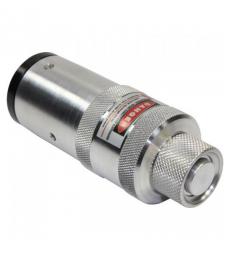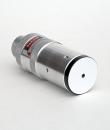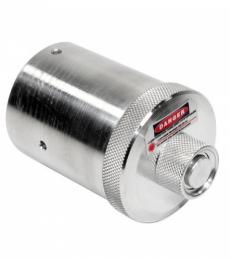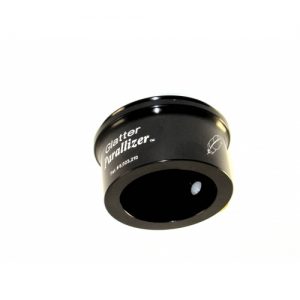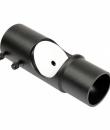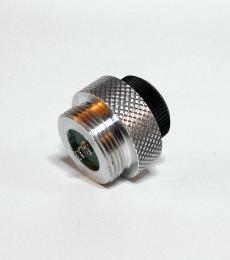SI-LC125-650—Single Red Beam 1.25" Laser Collimator – 650nm **BACK ORDERED**
$210.00
Available on backorder
Description
- Single deep red beam operates at 650nm.
- The Howie Glatter Holographic Laser Collimator incorporates a solid state laser diode that does not fade or change with time and use.
- Factory-aligned to 15 arc-seconds providing 0.1 inch accuracy at a distance of 20 feet,
- The Howie Glatter Laser Collimator is shock resistant to keep its alignment – even when dropped.
- Includes 123A lithium battery, 1mm aperture stop, and protective case.
Howie Glatter Single Deep Red Beam Laser Collimator 1.25″ 650nm
When it comes to lasers and collimation, one of the most trusted names in the business is guru Howie Glatter. His uncompromising quality and dedication to above average products, not only put his name above the rest – but in demand as the finest available on today’s market. Usually a manufacturer doesn’t take the time to explain to a customer exactly why their product excels over others – or why it performs better – but not Howie. Here’s what he has to say about his new Howie Glatter Laser Collimator:
“The lasers in my collimators are class IIIa lasers (maximum beam power: 5 thousandths of a Watt), and are quite safe if used with reasonable precaution. Direct or mirror-reflected eye exposure to the laser beam should always be avoided! You must be careful when collimating to ensure that the beam does not enter anyone’s eye. There is no problem in viewing the beam’s impact directly on a surface as long as the surface produces a diffuse reflection. The beam impact may also be safely viewed on a mirror or lens surface if the reflected or transmitted beam is not directed towards your eye. Information from studies I have seen suggests that in order to induce permanent damage, a class IIIa laser beam must stay focused on the retina for a long time. It’s unlikely for this to happen because the pupil is a very small target and because we have a blink and aversion reflex to bright light. However, all precautions should still be followed to avoid the beam entering anyone’s eye! A badly miscollimated Newtonian or Cassegrain telescope may allow the beam to exit the front of the telescope, so when collimating, check first by pointing the telescope at a wall or screen to see if the beam is getting out. With unobstructed telescopes such as refractors, the beam will always exit the front of the telescope, so run a strip of masking tape across a diameter of the dew cap opening as a safety beam stop.
Inside the collimator is a solid-state laser diode, which emits an intense laser beam through a front aperture, exactly along the central axis of the cylindrical collimator body. The beam acts as a “reference line” from which alignments are made. For a laser collimator it is of supreme importance that the beam be aligned with the collimator’s cylindrical axis, for if it is not, the resultant “alignment” of the telescope optics will be off-center and asymmetric, and the telescope will produce aberrated images.
When I started manufacturing laser collimators I realized that in order to produce consistent and accurate results they must be highly resistant to mechanical shock, so that internal laser alignment is maintained. I experimented with this aspect of collimator construction and developed a design which tremendously increased shock resistance. After aligning the laser within 15 arc seconds, I shock test each collimator by whacking it against a block of urethane plastic (urethane prevents marring), striking it at least a dozen times on three axis. I then recheck the laser alignment, and if it has not changed the collimator passes. I believe this is the most important difference setting my collimator apart from all others I know of. They will withstand a shock equivalent to dropping from eyepiece position, up the ladder on a big Dob, without alteration of laser alignment.
The beam from all red diode lasers used in collimators is fuzzy-edged and elliptical in cross-section. When collimating, you sometimes must judge the location of the center of the spot by eye. To improve collimating precision, all of my collimators (except 532nm) are supplied with a removable accessory plastic aperture stop having a 1mm hole, which push-fits into the laser aperture. It produces a tiny, circular beam impact which allows more accurate alignment. With the holographic collimators, it is not used at the same time as the holographic feature, and the diffractor must be removed to install the stop. With the stop inserted the beam impact at a distance of one meter or more looks like a star diffraction pattern, with a central dot surrounded by diffraction rings. The surrounding rings can help in centering the beam very accurately.
I offer the red holographic collimators with a choice of either 650 nanometer or 635nm wavelength. The two lasers have the same radiometric power output, but because the human eye’s sensitivity to the shorter wavelength is greater, the 635nm. laser appears about two or three times brighter. The higher cost of 635nm laser diodes increases the collimator price, but it enables holographic collimation in brighter ambient light. If you intend to collimate in early twilight, it is a good choice. In darkness, however, the 650nm laser is quite adequate. Because single beam collimators concentrate all the laser light in the central beam, the 650nm laser is quite adequate for them.”
Precise… Accurate… and Durable… What more could you ask?
Laser Collimating Instructions
Additional information
| Weight | 0.75 lbs |
|---|---|
| Holographic Attachment | Concentric Circle, Cross Hair Pattern, Not Interested, Square Grid Pattern |
| Variable Brightness Switch | Not Interested, Variable Brightness Switch Upgrade |

